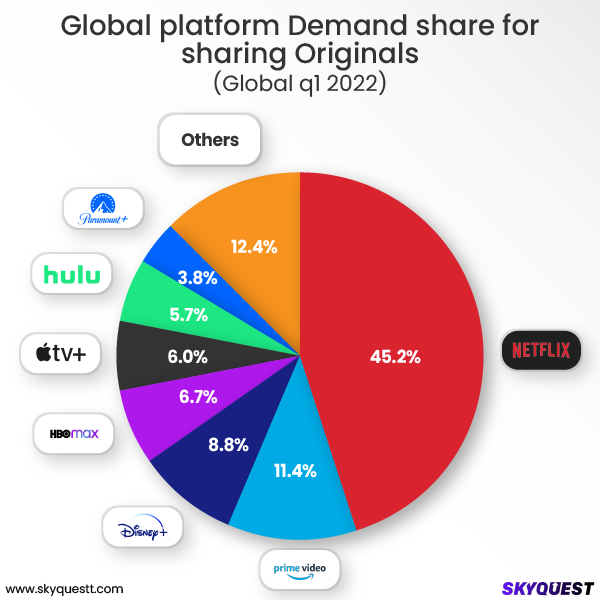How OTT is Changing the Streaming Landscape?
by Swarnima
6 min read

Video streaming platforms or over-the-top (OTT) content services are gaining immense popularity and driving market growth. The consumer behavior is shifting from traditional TV-based scheduled content to OTT-based on-demand viewing as a result hampering the traditional cable TV market growth. The cable TV market is anticipated to decline 3% year over year into 2031 as people leave for streaming services this in turn is likely to present lucrative opportunities to the over-the-top (OTT) market over the forecast period.
Digital content consumption in OTT platforms is rapidly growing as a result of easy access to smart devices and affordable mobile data plans. Aside from that, the multiple benefits of OTT services is driving the demand of OTT market over the years. For instance, OTT networks provide more than just portable media streaming. One can access ad-free services and download videos in many languages to watch offline on their devices for a minimal cost. Several television episodes and films are available on streaming sites well in advance of their airing on television. It is an ideal medium for first-time film or web series enthusiasts to expand their horizons. The multi-screen OTT experience is another major component that has contributed to the streaming industry's ever-growing client base and new quality content is further contributing to the market growth.

How live streaming is changing the entertainment industry?
The rapid increase in demand for live streaming channels, as well as the continued development of cloud-based OTT services, will propel market growth. Major sporting events, news, high-profile entertainment events, concerts, and product launches are increasingly being streamed live. Live streaming allows event organizers to reach a broader audience and generate additional cash through a new distribution method. OTT players are projected to provide additional live streaming channels. Furthermore, breaking news will be broadcast on Periscope, Facebook Live, and perhaps YouTube. Broadcasters in the United States are collaborating with multi-channel video programming distributors (MVPDs) to provide a ready version of live and linear feeds that may be bundled as OTT offers, hence supporting industry growth. As the COVID-19 pandemic began and lockdown was enacted, streaming of live material grew dramatically, which is beneficial to the market. For example, the live streaming sector rose by 45% between March and April of 2020, and these gains are directly related to the coronavirus pandemic. Furthermore, viewers are live streaming Twitch concerts, Zoom lectures, business meetings, and virtual book launches, which is projected to generate lucrative opportunities for the market.
How OTT Players are Winning the Marketing Game?
Developing original content is the top strategy of key players in global OTT market. Key OTT market participants have made considerable investments in the OTT market to generate original content, fueling market growth. For instance, In 2021, OTT platforms invested an estimated US$665 million in content, with Netflix, Amazon Prime Video, and Disney+ Hotstar leading the pack with a combined spend of US$380 million. Others, led by the Zee and Sony combo, are also gradually scaling their investments as they aim to catch up.
The demand for high-quality unique content increases as new companies enter the market. Firms such as Disney who once licensed their content to Netflix now operate in competition. As a result, Netflix and others have been compelled to become self-sufficient and produce their own content. However, this trend has given more chances to "indie" film producers rather than reducing the number of studios. The industry is now recognizing that exclusive content is the greatest way to attract new subscribers; whether these subscribers stick around will be explored further down the road. Shows like Disney's The Mandalorian and AppleTV's Ted Lasso have drawn new customers to the platform in pursuit of the best content bang for their budget. Social media has also played a significant influence in this trend.
Key players identified the bingeing habits of the users. Most consumers prefer binge watching all the episodes of a season. Netflix arguably pioneered current binge-watching habits by releasing all episodes of a new season of a series at the same time - a technique that bolstered the global appeal of series as diverse as House of Cards, The Crown, Emily in Paris, and Bridgerton. Amazon quickly followed suit with award-winning shows such as Transparent and The Marvelous Mrs. Maisel. Newer streamers have followed suit, though they have occasionally reverted to a more linear schedule. Disney, for example, has been streaming weekly episodes of Loki, WandaVision, and The Mandalorian, while Apple has done the same with Ted Lasso and The Morning Show.
Furthermore, OTT players are also introducing innovative monetization models as an alternative to subscription bundles and models, OTT platforms are shifting to monetization models such as pay-per-view. Pay-per-view is an OTT streaming service option in which a viewer pays to watch specific platforms via private telecast. Bundling different subscription packages to create platforms may become more popular. Disney+ monetization models with ESPN, NBC, and others are already visible. To avoid subscription fatigue, OTT platforms may continue to use the subscription bundle method in 2023.
How the demand for international content is changing the way we consume media?
The demand for international content is growing among the consumers. For instance, Netflix's SquidGame originally produced for the Korean market, SquidGame became a global sensation in 4 weeks. Another example of this trend is the growing popularity of anime, a Japanese form of cartoon aimed at young adults. These shows are available on practically every streaming platform. Crunchyroll, operated by Funimation, is a streaming service dedicated to these shows that has increased in popularity dramatically over the years. Platforms such as Netflix have greatly increased the amount of anime they offer over the years, owing to the shows' success in American markets. The ability to broadcast international material in other countries is a big advantage for streaming services because it helps them to maximize audience. Netflix has the largest share of international content among its peers, at over 45%.
Which market is the most lucrative for OTT services?
The global Over-the-Top (OTT) market is segmented based on the region into North America, South America, Europe, Asia-Pacific and Middle East & Africa. Among these, the North America region dominated the market with a majority of share. The region was valued at USD 48.72 billion in 2021 which is projected to reach USD 141.67 billion by 2028, growing at a CAGR of 16.5% during the forecast period. While, the Asia-Pacific region is poised to grow at a fastest CAGR of 16.9% during the forecast period. The region was valued at USD 36.80 billion in 2021 which is projected to reach USD 109.23 billion by 2028.

North America dominates the over-the-top (OTT) services market due to significant demand in the United States and Canada. The US dominated the market with a significant market share in 2021. The US was valued at USD 46.04 billion in 2021 which is projected to reach USD 133.98 billion by 2028, growing at a CAGR of 16.6% during the forecast period. Some of the primary drivers propelling the US OTT industry are the increasing penetration of smart devices such as smart TV and smartphones, increased demand for VOD content, and a high rate of per-user payment. Furthermore, the majority of the leading global OTT sellers, such as Netflix and Amazon, are situated in the United States, giving the regional market an advantage. The growing popularity of OTT content simultaneously liberates US citizens from cable, geographic restrictions, and broadcast schedules while also fundamentally altering the way video is sold, produced, and consumed. As a result of the limited genre options, package flexibility, increased device availability, internet penetration, and overall lower costs, adoption has increased. The most popular OTT platforms in the country are Netflix and Amazon.
The rising percentage of watch time on OTT video content, together with rising income, indicates the country's evolving entertainment industry. Globally, users watch OTT video for an average of 6.8 hours per week, with the United States topping the national statistics at 8.55 hours.

Streaming content is becoming more popular in the region as content owners such as Disney go direct to consumer and Telcos (AT&T) and OTT-only operators such as Amazon, to mention a few. Simultaneously, the introduction of 4K streaming has accelerated the expansion of OTT content available on smart TV platforms.
In year 2020, more than 65-70% of US broadband households own at least one streaming entertainment product, and 50% own a smart TV. OTT players such as Disney, Netflix, NFL, and NBC have been investing in creating OTT TV apps to bring their videos directly to consumers. With 40% of US homes already using a smart device to stream content, the percentage of smart TV penetration has significantly gone up.
Conclusion
In conclusion, over-the-top (OTT) streaming services have revolutionized the way we consume media. From Netflix to Disney+, OTT content services have disrupted the traditional television model by offering a wide variety of programming options, on-demand viewing, and the ability to stream content anywhere, anytime.
As streaming continues to gain popularity, it's clear that OTT services will play an increasingly important role in the entertainment industry. They have already had a significant impact on the way the film and television industry produces and distributes content, and it's likely that this trend will continue in the coming years.
However, OTT services are not without their drawbacks. As the number of streaming services continues to grow, it can be difficult for consumers to keep up with all the options, and the cost of subscribing to multiple services can add up quickly. Additionally, with so many options available, it can be challenging to find the content you want to watch.
Despite these challenges, it's clear that OTT streaming is here to stay. As consumers continue to demand more flexibility and control over their media consumption, OTT services will continue to evolve to meet these needs. Whether you're a casual viewer or a hardcore binge-watcher, OTT streaming offers something for everyone, making it a vital part of the entertainment landscape.





















 USA (+1) 351-333-4748
USA (+1) 351-333-4748
